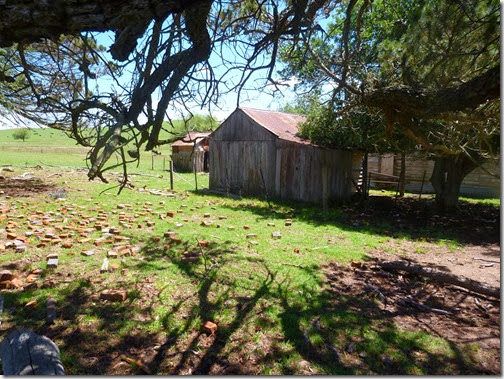If you know a little bit of history, you can find many things on New England roads, hints or signals of our shared past.
Those driving south along Thunderbolt’s Way will find a modern bridge marked Bergen-op-Zoom Creek, Irish Town Bridge. What a strange conjunction, one might ask, Dutch and Irish? Indeed, a friend did!
A little before the bridge on the left hand side of the road are a few old buildings with a sign that tells at least part of the story. It’s not a big sign. You have to watch for it.
In many parts of New England, families with common connection settled near each other, creating small communities. At Kelly’s Plains, for example, a small community of German Catholics developed – Brandschieds, Posts and Eichorns. At Irish Town, as the name suggests, it was the Irish.
At the time Irish Town was established, many squatters still preferred to employ single men. They were cheaper. Abraham Nivison from Ohio Station took a different view. He preferred  family men.
family men.
A devout Protestant, Abraham also surprised his fellow pastoralists by preferring Irish families. They were good workers, while their generally large families supplied a workforce at a time when labour was very scarce.
Some of those from Ohio and neighbouring Bergen-op-Zoom Station - shepherds, shearers and wheelwights - chose to live nearby each other on small allotments, creating the community that became known as Irish Town. From here, the men travelled for nearby work.
The blocks weren’t big. However, they allowed for vegetable gardens and fruit trees, perhaps a cow and another few animals, thus supplementing family income and adding variety to daily diet. There was also companionship and mutual support.
The Irish Town community was relatively short lived. By the 1870s, it was in clear decline as families were drawn away by other opportunities, including especially mining. Today, only Homeleigh remains, with the location of other houses marked just by trees.
Thomas and Bridget Blake occupied the land in the 1840s. The remaining buildings themselves date from the 1850s when Thomas and Bridget’s daughter Mary took up a block of 84 acres (34 hectares). The buildings survive because the Blake family and their descendents, the Betts family, lived here until the 1980s. They include the original one room Blake slab cottage and the original small dairy.
Action to preserve the site was taken by the Walcha and District Historical Society, with support from Walcha Shire Council. They arranged for an archaeological survey that showed the bond of shared cultural heritage motivating this Irish enclave. Now the site survives as a very rare example of the small selector’s home.
You can see the site from the road and it is worth stopping. However, Homeleigh is private property. If you would like to inspect properly, you will need to contact the Walcha and District Historical Society who can arrange a visit.
Note to readers: This post appeared as a column in the Armidale Express Extra on 15 January 2014. I am repeating the columns here with a lag because the columns are not on line outside subscription. You can see all the Belshaw World and History Revisited columns by clicking here for 2009, here for 2010, here for 2011, here for 2012, here for 2013, here for 2014.










No comments:
Post a Comment